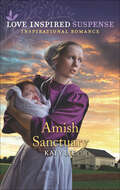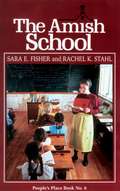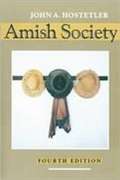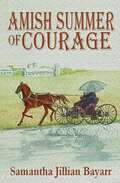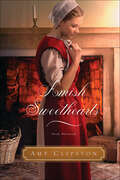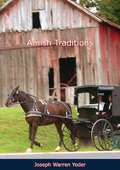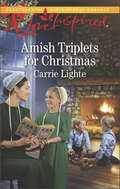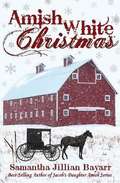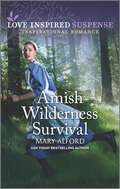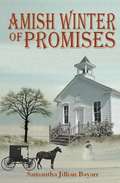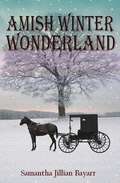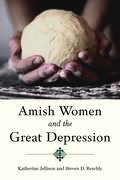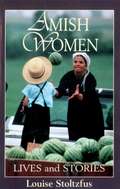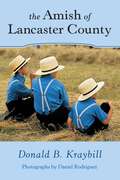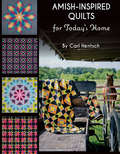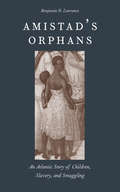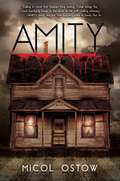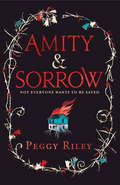- Table View
- List View
Amish Safe House: An Anthology (Amish Witness Protection #2)
by Debby GiustiHiding in Plain SightThe second thrilling Amish Witness Protection novelAfter Julia Bradford’s son witnesses a gang shooting, hiding in witness protection on Abraham King’s Amish farm is the only hope the Englischer and her children have. Even as danger closes in, Julia is drawn to the community’s peaceful ways—and the ex-cop turned Amish protector. But when their location is discovered, can Abraham protect her family…and possibly have a future by her side?
Amish Sanctuary
by Katy LeeFleeing danger, a woman returns to the community—and man—she left behind in this suspense-filled romance from the author of Amish Country Undercover.A woman on the run. A baby in danger.Can her Amish ex-fiancé save them?To keep her patient’s baby safe from a killer, counselor Naomi Kemp will do things she never thought possible, like return to her Amish hometown—and her ex-fiancé. Widower Sawyer Zook can offer Naomi and the baby protection and a place to hide. But Sawyer can’t shield Naomi from what threatens her most: the traumatic past that drove her away years ago . . .
Amish School (People's Place Book Ser. #6)
by Sara FisherRevised Edition! Sold more than 50,000 copies in earlier editions! The Old Order Amish believe that school prepares children for the Amish way of life, for the responsibilities of adulthood, and for eternity. Most communities conduct their own schools, usually taught by Amish teachers. Sara E. Fisher, an Old Order Amish woman, taught a one-room school for seven years. This is her fascinating insider's view of a typical Amish school. Includes "Diary of an Amish Schoolgirl." This authoritative book on Amish education deals with many questions: Why do the Amish have their own schools? How are teachers chosen? How are the parents involved? What curriculum materials are used? What about children with special needs? Co-author Sara Fisher writes from her experience as an Amish schoolteacher; co-author Rachel Stahl writes from her years of extensive research.
Amish Secrets (River Haven #3)
by Marta PerryRachel Hurst sacrificed the life she wanted to stay home and care for her father and siblings after her mother’s death. But now her father has decided to remarry, and there’s no room for Rachel. Desperate to find a job, she accepts the position of housekeeper for a wealthy elderly woman in her isolated mansion.Jacob Beiler thought he had gotten over Rachel’s rejection, but when she arrives as the new housekeeper, he is battered by both joy and bitterness at seeing her again.When odd near accidents threaten the elderly woman’s well-being, her relatives are quick to point fingers, but Rachel suspects someone is intent on harming her employer. When no one believes her, the only person she can turn to for help is Jacob. With danger deepening, Rachel faces a situation that could cost her life…and will certainly break her heart once again.
Amish Sleigh Bells: An Uplifting Inspirational Romance (Amish Country Matches #6)
by Patricia JohnsThey&’re worlds apart. Can love unite them? Spending yet another Christmas without a husband isn&’t something Lydia Speicher is looking forward to this season. Helping the new veterinarian, Thad Miller, navigate his way around the local farms is a welcome distraction, despite the Beachy Amish man&’s shocking customs. But when Lydia accidentally crashes Thad&’s truck and he&’s forced to borrow her family&’s sleigh, liberal Thad must live the conservative Old Order way of life until it&’s fixed. Lydia and Thad couldn&’t be more different, but while working together highlights their similarities, are they willing to change for love?From Love Inspired: Uplifting stories of faith, forgiveness and hope.Amish Country Matches Book 1: The Amish Matchmaking DilemmaBook 2: Their Amish SecretBook 3: The Amish Marriage ArrangementBook 4: An Amish Mother for His ChildBook 5: Her Pretend Amish BeauBook 6: Amish Sleigh Bells
Amish Society (4th Edition)
by John A. HostetlerHighly acclaimed in previous editions, this classic work by John Hostetler has been expanded and updated to reflect current research on Amish history and culture as well as the new concerns of Amish communities throughout North America.
Amish Soups & Casseroles: Traditional Comfort Food Favorites
by Byler Linda Laura Anne Lapp Anna Kauffman Emily Stoltzfus75 authentic Amish soups, stews, casseroles—and delicious bread to go with them. Gathered from interviews with real Amish grandmothers, tattered recipe boxes, and old books and diaries, here is an assortment of delicious baked goods that have been and continue to be popular in eastern Pennsylvania, particularly in the Lancaster area. Now you too can experience the warm, comforting recipes of old order Amish cooks. Prepare to make wonderful treats such as: Chicken Corn SoupHam, Green Beans, and Potato StewBeef Vegetable SoupRivvel SoupBreakfast CasseroleGreen Bean and Sausage CasseroleRoasht (or Chicken Filling)Becky Zook BreadPotato RollsAnd more!These recipes will soon become your family favorites and go-to meals for church suppers or potluck dinners. With simple ingredients and instructions that are easy to follow, you'll find yourself whipping up the same wonderful and comforting meals you'll find in Amish country.
Amish Summer Of Courage: Book Six
by Samantha BayarrLizzie's troubled past has finally come full circle. When Levi Schrock shows up to work as a hired hand on her father's farm, no one suspects he has anything to hide. A chance meeting with her daughter, Rachel, on his first day in town could change Levi's mind about his plans, as wellas his heart.
Amish Sweethearts: Four Novellas
by Amy ClipstonLove is in the air in these four sweet romances!Love and Buggy Rides (previously published in An Amish Harvest)Janie Lantz is a cashier at Lancaster Souvenirs and Buggy Rides, where Jonathan Stoltfuz is a buggy driver. A frightening accident brings Janie and Jonathan together in a blossoming friendship, yet daunting obstacles stand between them and something deeper. Can love kindle into flames that burn away fear and regret—and lead them to a life together?A Home for LindsayFrom Amy Clipston&’s beloved Kauffman Amish Bakery series comes Lindsay Bedford&’s story. Lindsay is happily looking forward to the day she becomes Matthew Glick&’s wife and is excited for the plans he has for the house he will build her. So, when Matthew suddenly calls off the wedding, she is blindsided. She knows there is more to the story than what he is telling her, but will he open up and let her in on his own heartbreak?Where the Heart IsTobias Smucker is back home, and it&’s no secret he and his father are still not on the best of terms. But what is surprising is that his little sister&’s best friend, Mariella, has been harboring her own secret feelings for Tobias. With her help, he begins to unravel a family mystery and learns that everyone has their own hidden depths, including his father.Love Birds (previously published in An Amish Market)While Ellie Lapp and her mother are still mourning the loss of her brother, Seth, Ellie starts working at one of the gift shops in town. Seth&’s friend Lloyd is talented at carving wooden birds, but his father disapproves and expects him to take over the family farm someday. Ellie sees the beauty in Lloyd&’s creations and insists Lloyd sell the birds in the gift shop where she works. As Ellie and Lloyd spend more time together, they begin to develop feelings for one another, but she accidentally betrays his trust. Will she lose any hope of a future with him?
Amish Traditions
by Joseph Warren Yoder“Joseph Yoder (September 22, 1872 – November 13, 1956) was an educator, musicologist, and writer, the first successful Mennonite literary figure in the United States, especially known for his semi-fictional account of his mother's life, Rosanna of the Amish (1940), and for his investigation of the sources of the Amish tunes of the Ausbund, along with his efforts to record and preserve traditional Amish music.”-Wiki“I felt that someone who knows the Amish should write a truthful book about them and show the world their good qualities, instead of magnifying; their peculiarities. So, after thinking about it for about twenty years, and after reading a book called “Straw in, the Wind,” which I thought was very unfair, I determined to write my book, “Rosanna of the Amish.” But may I say that writing a book is no small job. First, it takes a lot of work; second it takes a lot of money to have it printed, but those are not the worst things to think about. What are you going to do if the people do not like your book, do not buy it, and you lose everything you put into it? Even though these discouraging things stared me in the face, I wrote it anyway, and may I say without boasting, that since seven printings have already been made and the book is still selling well, and every now and then I receive a letter from some far off country saying how much they liked Rosanna of the Amish, I am not sorry that I wrote it.”-From the Author’s introduction.
Amish Triplets for Christmas
by Carrie LighteA widowed Amish father finds new hope—and love—with the help of a teacher in this inspirational holiday romance.Widowed father of triplets Sawyer Plank knows he has his hands full. After arriving in the Amish community of Willow Creek to help with the fall harvest, Sawyer asks schoolteacher Hannah Lantz to be his nanny. With a deaf grandfather to care for, the offer is more than just a job for Hannah—it’s a chance to fulfill her all-but-forgotten dream of being a mother. The children soon flourish under Hannah’s watch, and though Sawyer never dreamed he’d find happiness again, he can’t pretend he’s not falling for her, too. But with the holiday season heralding Sawyer’s return to Ohio, can he make his Christmas wish to stay a family come true?
Amish White Christmas: Amish Winter Collection (Book Two)
by Samantha BayarrSNOWFLAKES ON GOOSE POND: Ruby Miller is the best ice skater in the community, and Jesse Fisher wants lessons from her. Will Priscilla, her overbearing cousin, get in the way? SNOW ANGELS: Priscilla Miller has closed off her heart since the buggy accident that took the lives of her father and brother. Will Tobias Fisher and his quest for making snow angels, break her heart or mend it? THE GINGERBREAD HAUS: Eden Fisher is devastated when she sees the home she has always called "the gingerbread haus" is scheduled for demolition. Can Gabriel Miller, who has loved her since grade school, keep the haus and her dreams intact?
Amish Wilderness Survival
by Mary AlfordTo stay alive, she must escape a killer&’s clutches When her brother goes missing, Leora Mast will do anything to find him…even if it means putting her life in danger. Upon arriving in Montana, she finds an ally in Fletcher Shetler, but almost as soon as they meet, they&’re running for their lives. With Fletcher&’s help, Leora must unravel the truth about her brother&’s disappearance…before the man who wants them dead tracks them down.From Love Inspired Suspense: Courage. Danger. Faith.
Amish Winter Of Promises: Book Four
by Samantha BayarrCaleb has a secret he's been harboring all his life. When Katie Graber, the new school teacher, meets up with him, it seems she has a secret of her own. Seeing an opportunity to get out of an arranged marriage, she enlists the help of Caleb in exchange for helping him, and the two find that breaking promises always costs more than the benefits of keeping them.
Amish Winter Wonderland (Jacob's Daughters #2)
by Samantha BayarrTwenty-five-year-old Lillian STOLTZFUS is living in the shadow of her deceased brother. When her dad gives her the gift of land that would normally go to the eldest son, it includes a bakery he built as an offering to a suitor for her. No one wants marriage for Lillian more than she wants it for herself, but at twenty-five, she fears she will end up a spinster if Seth never returns her secret feelings for him. Thirty-year-old Seth Miller is loaded down with the responsibility of caring for an overbearing father. His loyalty to his father's farm has caused him to put his own needs on hold his entire adult life. Being secretly in love with Lillian for many months, he finds it difficult to speak to her because he lacks the confidence having never dated before. Will the contents of an old spice box change everything for both of them? Or are they destined to admire each other from afar indefinitely?
Amish Witness to Murder (Amish Country Justice #18)
by Dana R. LynnTo identify her father&’s killer… she must stay alive After finding her family&’s barn in flames and witnessing her father&’s murder, Beth Troyer becomes the killer&’s next target. She narrowly escapes death when the murderer turns on her, but now she&’s left temporarily blind. She&’ll have to rely on former family friend Gideon Bender to keep her safe until her eyesight returns. But with a killer who&’ll stop at nothing to find her, staying alive might just be impossible…From Love Inspired Suspense: Courage. Danger. Faith.Amish Country Justice Book 1: Plain TargetBook 2: Plain RetributionBook 3: Amish Christmas AbductionBook 4: Amish Country AmbushBook 5: Amish Christmas EmergencyBook 6: Guarding the Amish MidwifeBook 7: Hidden in Amish CountryBook 8: Plain RefugeBook 9: Deadly Amish ReunionBook 10: Amish Country ThreatsBook 11: Covert Amish InvestigationBook 12: Amish Christmas EscapeBook 13: Amish Cradle ConspiracyBook 14: Her Secret Amish PastBook 15: Crime Scene WitnessBook 16: Hidden Amish TargetBook 17: Hunted at ChristmasBook 18: Amish Witness to MurderBook 19: Protecting the Amish Child
Amish Women and the Great Depression (Young Center Books In Anabaptist And Pietist Studies)
by Katherine Jellison and Steven D. ReschlyAmish Women: Lives And Stories
by Louise StoltzfusWritten by a woman who grew up in an Old Order Amish community and church, Amish Women: Lives and Stories offers a gentle, lyrical inside view of Amish womanhood. How are Amish women unique? How are they typical? How do they find expression in a place that values community togetherness above all else? This generous and heartwarming memoir explores these questions to discover what it means to be a woman and to be Amish. Meet Naomi whose favorite author is C.S. Lewis. Rebecca who is single and has a career. Susie who is an artist. And Esther who has lost two children and spends much of her time reaching out to other members of her community who have suffered loss. Louise Stoltzfus gathered her stories through a series of interviews and conversations with Amish women, many of whom she has known most of her life. Little has been written about Amish women. How are they regarded within their highly structured community? How whole are they as individuals? This insightful, gently probing, yet always respectful text opens a door to this nearly hidden world. Profiles 10 Amish women; written by a woman reared in an Amish family.
Amish of Lancaster County
by Donald B. KraybillPrimer to understanding Amish life for visitors. Captivating color photography. Insight on recent media events.
Amish-Inspired Quilts for Today's Home: 10 Brilliant Patchwork Quilts
by Carl HentschThe noted quilt designer shares his love of Amish craftsmanship with 10 new patchwork quilt patterns in this step-by-step guide.Carl Hentsch has always admired Amish quilts and quilters. Living only a short distance from an old-order Amish community has allowed him to explore their world, meet some of the quilters themselves, and more fully appreciate their ability to create beautiful quilts without the use of electricity. Amish-Inspired Quilts for Today’s Home explores their use of color and design in 10 quilts using modern fabrics and techniques. Ranging from easy to challenging, these projects offer beautiful bursts of color in blocks such as Basket, Log Cabin, and Star.
Amistad's Orphans
by Benjamin Nicholas LawranceThe lives of six African children, ages nine to sixteen, were forever altered by the revolt aboard the Cuban schooner La Amistad in 1839. Like their adult companions, all were captured in Africa and illegally sold as slaves. In this fascinating revisionist history, Benjamin N. Lawrance reconstructs six entwined stories and brings them to the forefront of the Amistad conflict. Through eyewitness testimonies, court records, and the children's own letters, Lawrance recounts how their lives were inextricably interwoven by the historic drama, and casts new light on illegal nineteenth-century transatlantic slave smuggling.
Amistad: A Long Road to Freedom
by Walter Dean MyersIn 1839, a young man named Sengbe Pieh led a group of illegally enslaved Africans to revolt against their captors aboard the slave ship Amistad. All they wanted was to return home to their families. Instead, the Africans landed in the United States, where they were imprisoned and charged with murder. In the historic case that followed, abolitionists came to the Amistad captives' defense. Sengbe Pieh continued as the group's leader, learning enough English to speak out in court for the freedom they so desperately needed. Award-winning author Walter Dean Myers's look at the Amistad rebellion shows how this complicated struggle against bigotry and injustice was an important victory in our nation's fight for equality for all.
Amity
by Micol OstowHere is a house of ruin and rage, of death and deliverance. Here is where I live, not living. Here is always mine. When Connor's family moves to Amity, a secluded house on the peaceful banks of New England's Concord River, his nights are plagued with gore-filled dreams of demons, destruction, and revenge. Dreams he kind of likes. Dreams he could make real, with Amity's help. Ten years later, Gwen's family moves to Amity for a fresh start. Instead, she's haunted by lurid visions, disturbing voices, and questions about her own sanity. But who would ever believe her? And what could be done if they did? Because Amity isn't just a house. She is a living force, bent on manipulating her inhabitants to her twisted will. She will use Connor and Gwen to bring about a violent end as she's done before. Inspired by a true-crime story, Amity spans generations to weave an overlapping, interconnected tale of terror, insanity, danger, and death.
Amity & Sorrow: A Novel
by Peggy RileyA mother and her daughters drive for days without sleep until they crash their car in rural Oklahoma. The mother, Amaranth, is desperate to get away from someone she's convinced will follow them wherever they go--her husband. The girls, Amity and Sorrow, can't imagine what the world holds outside their father's polygamous compound. Rescue comes in the unlikely form of Bradley, a farmer grieving the loss of his wife. At first unwelcoming to these strange, prayerful women, Bradley's abiding tolerance gets the best of him, and they become a new kind of family. An unforgettable story of belief and redemption, AMITY & SORROW is about the influence of community and learning to stand on your own.
Amity & Sorrow: A Novel
by Peggy RileyAMITY & SORROW is a story about God, sex, and farming. It's THE LOVELY BONES meets WITNESS: an unforgettable journey into the horrors a true believer can inflict upon his family, and what it is like to live when the end of the world doesn't come.In the wake of a suspicious fire, Amaranth gathers her children and flees from the cult where her children were born and raised. Now she is on the run with no one but her barely-teenage daughters, Amity and Sorrow, neither of whom have ever seen the outside world, to help her. After four days of driving without sleep, Amaranth crashes the car, leaving the family stranded at a gas station, unsure of what to do next. Rescue comes in the unlikely form of a downtrodden farmer, a man who offers sanctuary when the women need it most. AMITY & SORROW is the story of these remarkable women, their lives before the night they fled, and their heartbreaking, hopeful future. Over the course of a season Amaranth will test the limits of her faith, and her daughters will test the limits of her patience. While Amity blossoms in this new world, free from her father's forbidding rules and ecstatic worship, Sorrow will move heaven and earth trying to get back home... And, meanwhile, the outside world hasn't forgotten about the fire on the compound.

